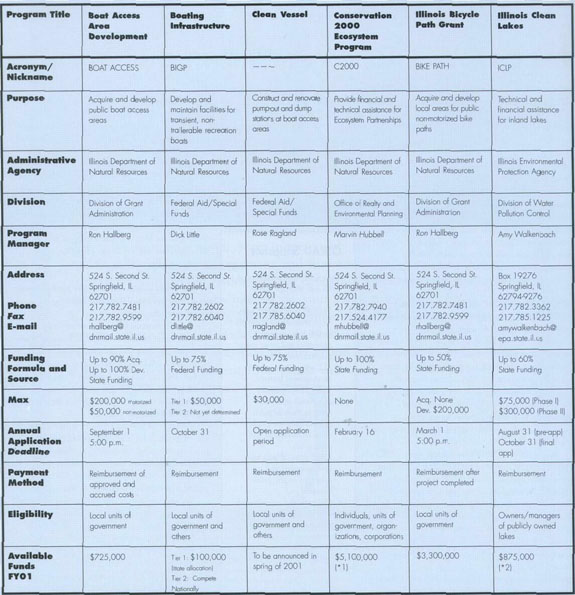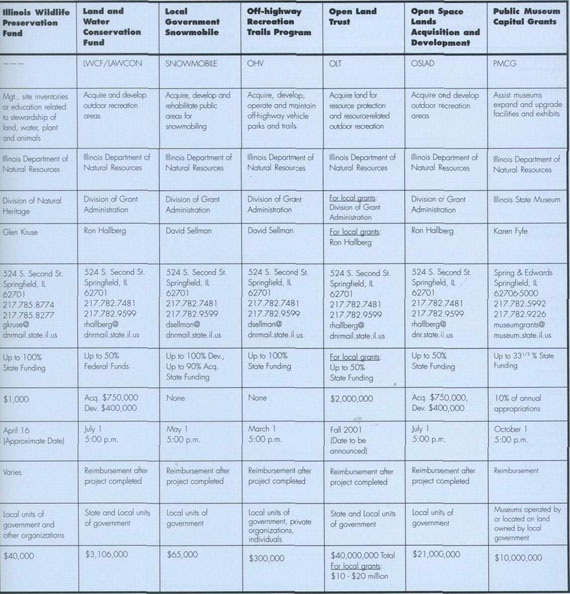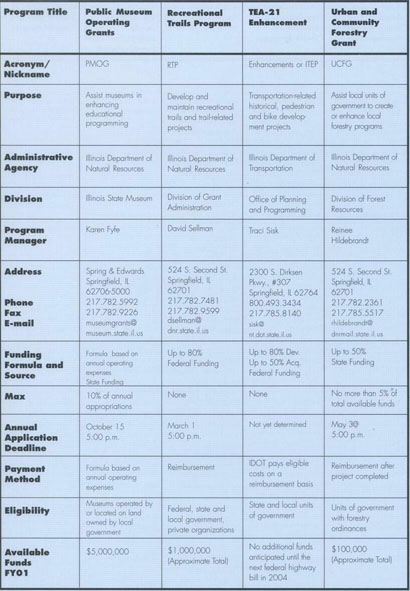 |
Home | Search | Browse | About IPO | Staff | Links |
 |
Home | Search | Browse | About IPO | Staff | Links |
|
GRANTS OUTLOOK 2001
For this edition of Illinois Parks & Recreation magazine's annual Grants Outlook, we interviewed Mark Yergler, chief grant administrator for the Illinois Department of Natural Resources Division of Grant Administration, to learn the latest about the DNR-administered grants and insider tips for the application process.
IP&R: What's the outlook for the Open Space Lands Acquisition and Development (OSLAD) program? Yergler: The OSLAD program continues to grow due to the strong economy. OSLAD funding increased to $21 million for the FY2001 appropriations and that's up from $20 million last fiscal year. Another welcome increase is in project limits for OSLAD. Agencies can now request up to $400,000 for development projects and $750,000 for acquisition projects. This change is long overdue. IP&R: Who received the Open Land Trust (OLT) monies this year and what how do you expect the program to work next year? Yergler: As you know, in July of 1999, Governor Ryan signed the Open Land Trust into law, authorizing $40 million annually for the next four years to improve Illinois' standing with respect to available public open space and to help control sprawl. This is a major issue—especially in Chicago's collar counties and downstate urban areas—and a major concern of Governor Ryan's. In October of 2000, fifteen local agency OLT projects were approved totaling $18.17 million to acquire approximately 2,100 acres of open space. The majority of the projects approved were in northern Illinois, where open space is disappearing so rapidly due to all the growth in the region. We need to preserve it before its gone. Three of those projects were awarded to park districts, six to forest preserve districts, one conservation district and the rest were municipalities and counties. For fiscal year 2001, we have 19 local OLT requests currently under consideration. Grant awards won't be decided until early spring. IP&R: How did the Land and Water Conservation Fund (LWCF) fare with the final version of CARA that passed in Congress last October? Yergler: The LWCF stateside portion has been restored for FY2000 to $1.3 million for Illinois' apportionment. In 2001, it increased to $3.1 million, as a result of a push for the passage of the Conservation and Reinvestment Act (CARA). As introduced by the U.S. House, CARA would have provided $3 billion per year for a 15-year period nationwide. Illinois' portion would have reached approximately $53 million per year, which included more than $15 million in LWCF funds. In addition, the Urban Park and Recreation Recovery Program (UPARR) would have been fully funded. While Congress ultimately provided limited funding in the Interior Appropriations bill, the fight for these monies by a national coalition of conservation interests will continue when the new Congress takes office in 2001. IP&R: What advice can you give park districts and forest preserves regarding applying for a grant from the DNR? Yergler: The main thing is certainly to start early. It never fails that we get calls about grant applications when the deadline is less than a week away. Make sure the project is justified by a plan, that it's not just a whim. Planning for the grant project should begin at least a year in advance and be part of the agency's long-range capital development plan. Another important factor is public input. If the proposal is for a neighborhood park, the local agency needs to show they received input from neighborhood meetings, maybe even changed the plan based on them. We believe public involvement is critical to the process. Its also important that the project provides for diversity of recreational interests. It should not be focused on a single item, but rather it should address a variety of recreational needs. Also, there's got to be local need in terms of the facility. If a community wants to put in soccer fields and their community already has a lot of soccer fields, according to state averages, from our perspective, they don't need more. (Continued on page 41)
January/February 2001 / 37

* 1 Funds distributed through approved partnerships only *2 Approximate total, dependent on annual appropriation
38 / Illinois Parks and Recreation
PARKS, RECREATION, CONSERVATION LANDS & FACILITIES

* 1 Funds distributed through approved partnerships only *2 Approximate total, dependent on annual appropriation
January/February 2001 / 39
GRANTS OUTLOOK 2001 CONTINUED

* 1 Funds distributed through approved partnerships only *2 Approximate total, dependent on annual appropriation
40 / Illinois Parks and Recreation
GRANTS OUTLOOK 2001 CONTINUED
(Continue from page 37)
IP&R: What's your advice for an agency that "makes the cut" and is preparing for its final pitch, the three-minute presentation to the Department's Natural Resources Advisory Board in Springfield? Yergler: Don't waste the three minutes going over general community information and describing the benefits of recreation and physical activity to society. You need to focus on telling the advisory board "this is what we are doing and this is why we need your help." For example, "we have so many kids in our youth soccer and only one field." Give these kinds of specifics. Then, be prepared to answer questions from the advisory board. •
Editor's Note: Yergler also says that a number of park districts have found success in applying for tourism grants from the Illinois Department of Commerce and Community Affairs (DCCA). See DCCA's Web site (www.enjoyillinois.com), the Industry Insights section for information on three grants that are particularly applicable: Tourism Attraction Development Grant and Loan Program, Tourism Private Sector Grant Program, and the Marketing Partnership Program. January/February 2001 / 41 |
|
|